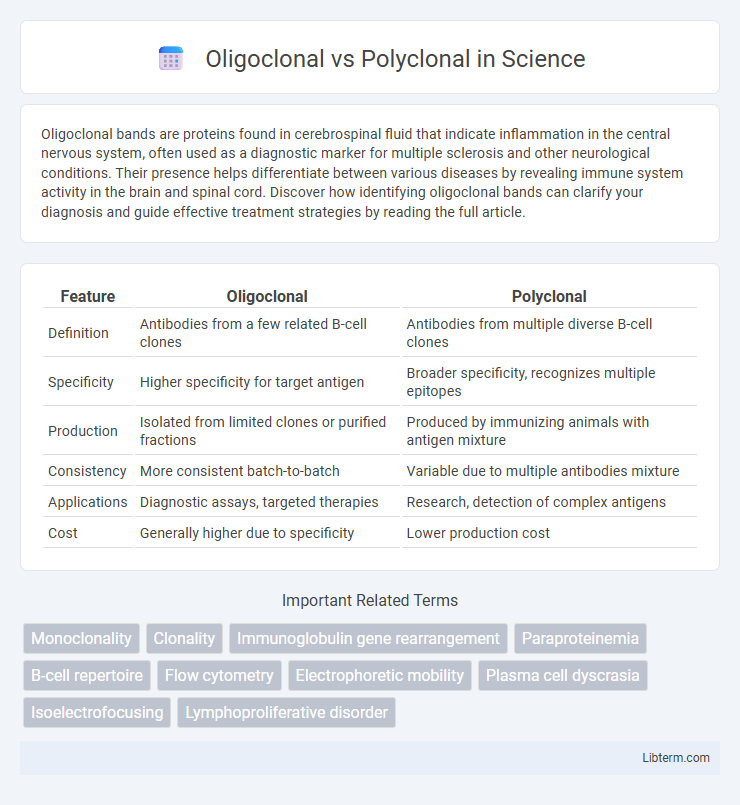Oligoclonal bands are proteins found in cerebrospinal fluid that indicate inflammation in the central nervous system, often used as a diagnostic marker for multiple sclerosis and other neurological conditions. Their presence helps differentiate between various diseases by revealing immune system activity in the brain and spinal cord. Discover how identifying oligoclonal bands can clarify your diagnosis and guide effective treatment strategies by reading the full article.
Table of Comparison
| Feature | Oligoclonal | Polyclonal |
|---|---|---|
| Definition | Antibodies from a few related B-cell clones | Antibodies from multiple diverse B-cell clones |
| Specificity | Higher specificity for target antigen | Broader specificity, recognizes multiple epitopes |
| Production | Isolated from limited clones or purified fractions | Produced by immunizing animals with antigen mixture |
| Consistency | More consistent batch-to-batch | Variable due to multiple antibodies mixture |
| Applications | Diagnostic assays, targeted therapies | Research, detection of complex antigens |
| Cost | Generally higher due to specificity | Lower production cost |
Introduction to Oligoclonal and Polyclonal
Oligoclonal antibodies are derived from a limited number of B-cell clones, producing a more specific and targeted immune response compared to polyclonal antibodies, which originate from multiple B-cell clones. Polyclonal antibodies recognize multiple epitopes on a single antigen, increasing sensitivity but reducing specificity, whereas oligoclonal antibodies strike a balance by targeting fewer epitopes with enhanced precision. This distinction is critical in applications like diagnostics and therapeutics, where specificity and sensitivity must be carefully managed.
Defining Oligoclonality
Oligoclonality refers to the presence of a limited number of distinct clones of cells or antibodies, often identified through molecular or immunological assays. This contrasts with polyclonality, where a diverse array of clones originates from multiple distinct progenitor cells, reflecting a broad immune response. Detection of oligoclonal bands in cerebrospinal fluid is a key diagnostic marker in diseases like multiple sclerosis, underscoring the clinical relevance of defining oligoclonality.
Understanding Polyclonality
Polyclonality refers to the presence of multiple distinct clones of cells, each producing unique antibodies targeting various epitopes on an antigen, enhancing immune response diversity and adaptability. In contrast to oligoclonal populations, which originate from a few dominant clones, polyclonal responses reflect the activation of numerous B-cell lineages, providing broader pathogen recognition and improved immunological defense. Understanding polyclonality is crucial in immunology research, vaccine development, and diagnostic applications, as it influences antibody specificity, affinity, and overall therapeutic efficacy.
Key Differences Between Oligoclonal and Polyclonal
Oligoclonal antibodies originate from a limited number of B-cell clones, targeting a few specific epitopes, whereas polyclonal antibodies arise from multiple B-cell clones recognizing numerous epitopes on the same antigen. Oligoclonal antibodies offer higher specificity and reduced cross-reactivity compared to the broader binding profile of polyclonal antibodies. In diagnostic and therapeutic applications, the controlled binding affinity and epitope diversity of oligoclonal antibodies provide better reproducibility and precision than the heterogeneous nature of polyclonal antibodies.
Biological Significance of Oligoclonal Populations
Oligoclonal populations consist of a limited number of immune cell clones, often highlighting a focused immune response or chronic antigen exposure, such as in multiple sclerosis where oligoclonal bands in cerebrospinal fluid indicate intrathecal IgG synthesis. These populations imply selective expansion and persistence of specific B or T cell clones, reflecting immune system adaptation or pathological conditions. Understanding oligoclonality aids in diagnosing autoimmune diseases, monitoring infection progression, and evaluating vaccine responses with higher precision than polyclonal diversity.
Clinical Importance of Polyclonal Responses
Polyclonal responses generate a diverse range of antibodies targeting multiple epitopes, enhancing immune defense against pathogens and improving vaccine efficacy. This broad reactivity reduces the risk of immune escape by mutated viruses or cancer cells, contributing to more robust and lasting immunity. In contrast, oligoclonal responses are limited to fewer antibody species, potentially restricting the immune system's adaptability in clinical settings.
Diagnostic Applications: Oligoclonal vs Polyclonal
Oligoclonal antibodies are highly specific, targeting a limited set of epitopes, making them ideal for precise diagnostic applications such as detecting multiple sclerosis through cerebrospinal fluid analysis. Polyclonal antibodies recognize multiple epitopes on an antigen, providing robust signals and enhanced sensitivity in assays like ELISA and Western blotting. Selecting between oligoclonal and polyclonal antibodies depends on the need for specificity versus sensitivity in diagnostic tests.
Laboratory Methods for Detection
Oligoclonal bands are detected using isoelectric focusing (IEF) combined with immunoblotting, providing high sensitivity for identifying distinct immunoglobulin patterns typically seen in multiple sclerosis. Polyclonal antibody detection relies on enzyme-linked immunosorbent assay (ELISA) and Western blot techniques to recognize a broad range of antigen epitopes, useful for assessing general immune responses. Laboratory methods for oligoclonal band analysis require cerebrospinal fluid and serum comparison to distinguish intrathecal immunoglobulin production from systemic sources.
Oligoclonal and Polyclonal in Disease Contexts
Oligoclonal antibodies target a limited number of epitopes, often indicating a more focused immune response commonly observed in chronic infections and autoimmune diseases like multiple sclerosis. Polyclonal antibodies recognize multiple epitopes and provide broader immune protection, frequently seen in acute infections and vaccination responses. Understanding the distinction between oligoclonal and polyclonal antibody profiles helps in diagnosing disease states and tailoring therapeutic interventions.
Conclusion and Future Perspectives
Oligoclonal antibodies offer high specificity by targeting a limited number of epitopes, enhancing diagnostic precision and therapeutic efficacy, while polyclonal antibodies provide broader antigen recognition, beneficial for detecting diverse or variable targets. Advances in antibody engineering and high-throughput screening technologies are expected to refine the balance between specificity and sensitivity, enabling tailored immunoassays and personalized treatments. Future perspectives include integrating artificial intelligence and synthetic biology to develop hybrid antibody formats that combine the strengths of both oligoclonal and polyclonal approaches for improved clinical and research applications.
Oligoclonal Infographic

 libterm.com
libterm.com